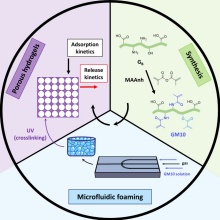To obtain gelatin-based hydrogels, aqueous gelatin solutions can be poured into molds and gelled - either physically or chemically. This procedure is usually very simple, but results in a material with a very small surface area, which is particularly disadvantageous for drug delivery applications.
In this project, gelatin-based materials with a large surface area will be produced, namely porous hydrogels with pore sizes of ~200 - 450 µm. The goal is to use pore size to control diffusion pathways of model drugs and thus release kinetics. Other control parameters for the release kinetics are the drug concentration and the isoelectric point (IEP) of the hydrogel. Measurements will be made as a function of pore size, porosity, and pore connectivity, as these structural elements control diffusion pathways within the hydrogel matrix. It will be clarified how structure and release rates are related, which will greatly increase the understanding of structure-property relationships of these systems. "Fine tuning" the release kinetics via changes in IEP and drug concentration will result in materials with controllable release rates.
To produce these materials with the desired properties, (1) gelatin-based porous hydrogels with tailored composition and structure will be synthesized and characterized, and (2) the adsorption and release behavior of these materials will be investigated for three different model drugs. Release kinetics of selected samples will be studied in a physiological buffer at 37°C to simulate biologically relevant conditions

Robin Benedix
PhD Student

Cosima Stubenrauch
Prof. Dr.Dean of Faculty
- Profile page
- +49 711 685 64470
- Write e-mail
- Secretary: Room 9-302; Tel. +49 711 685-64451 and -64393; sekretariat2@ipc.uni-stuttgart.de


